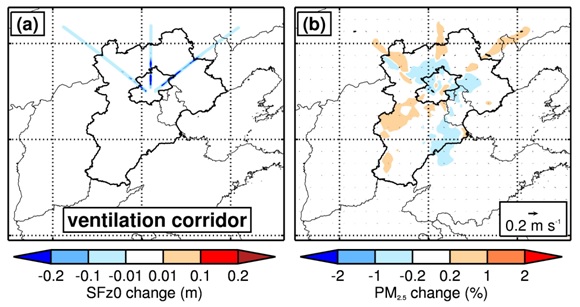Dr. LI Guohui, from Key Laboratory of Aerosol Science & Technology, Institute of Earth Environment, Chinese Academy of Sciences, with his colleagues, has quantified the effect of afforestation on PM2.5 in the Beijing–Tianjin– Hebei area (BTH). This study was recently published in Atmospheric Chemistry and Physics.
Although aggressive emission control strategies have been implemented recently in the BTH, China, pervasive and persistent haze still frequently engulfs the region during wintertime. Afforestation in BTH, primarily concentrated in the Taihang and Yan Mountains, has constituted one of the controversial factors exacerbating the haze pollution due to its slowdown of the surface wind speed.
The annual land cover product derived from the MODIS (Moderate Resolution Imaging Spectroradiometer) observations since 2001 has been used to analyze the land cover change in BTH. A considerable increasing trend of forests in the western and northwestern BTH has been identified, which is caused by China’s national afforestation programs. Forests in BTH and Beijing have increased by 7.2 % and 14.9 %, respectively, from 2001 to 2013. The fast forest expansion has increased the surface roughness height, particularly in Beijing and its surrounding areas.
WRF-CHEM (Weather Research and Forecasting model coupled to Chemistry) Sensitivity studies have demonstrated that the increase of the surface roughness height decreases the northwesterly or northerly wind speed in the western and northwestern BTH by about 0.3–1.5 m·s-1.The haze pollution is deteriorated in BTH to some degree, and PM2.5 concentrations are generally enhanced by less than 6% due to the afforestation.
The occurrence of heavy haze pollution in BTH is generally associated with the weakening of northerly or north- westerly winds, which facilitates the accumulation of air pollutants in BTH. The afforestation in the western and northwestern BTH increases the surface roughness height, further decelerating northerly or northwesterly winds and deteriorating the haze pollution. However, the afforestation only plays a marginal role in worsening the haze pollution and does not constitute the main cause of the heavy haze formation.
Additionally, the model results do not support that the proposed large ventilation corridor system is beneficial to alleviate the haze pollution in Beijing. Under the unfavorable synoptic situations, emissions mitigation is the sole optimum approach to mitigate the haze pollution in BTH.

Fig.1 (a) SFz0 change from 2001 to 2013, and (b) its correlation with the forest LCF change; horizontal distribution of (c) absolute and (d) relative near-surface PM2.5 mass concentration changes caused by the afforestation. The wind field changes are shown in black arrows in (c) and (d). (Image by LI, et al.)

Fig.2 Impacts of an artificial large ventilation corridor system on (a) SFz0 and (b) average near-surface PM2.5 mass concentrations from 1 December 2013 to 31 January 2014, along with the wind field (black arrows). (Image by LI, et al.)
Contact: Bai Jie, Institute of Earth Environment, Chinese Academy of Sciences, Xi'an, China. Email:baijie@ieecas.cn © 2015 Institute of Earth Environment,CAS
© 2015 Institute of Earth Environment,CAS Address:No. 97 Yanxiang Road, Xi'an 710061, Shaanxi, China

 Location :
Location :